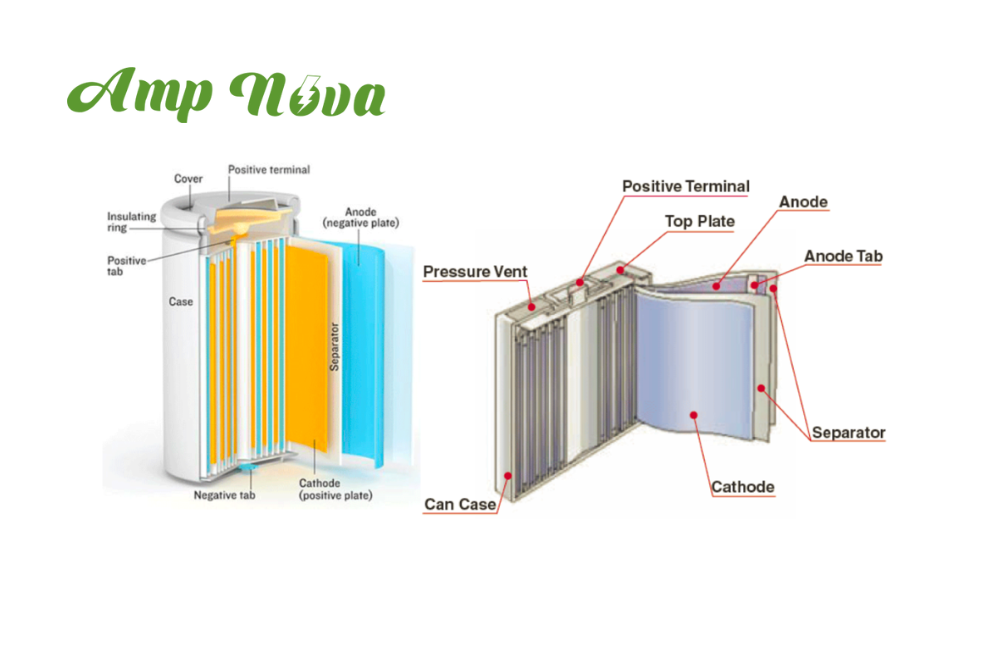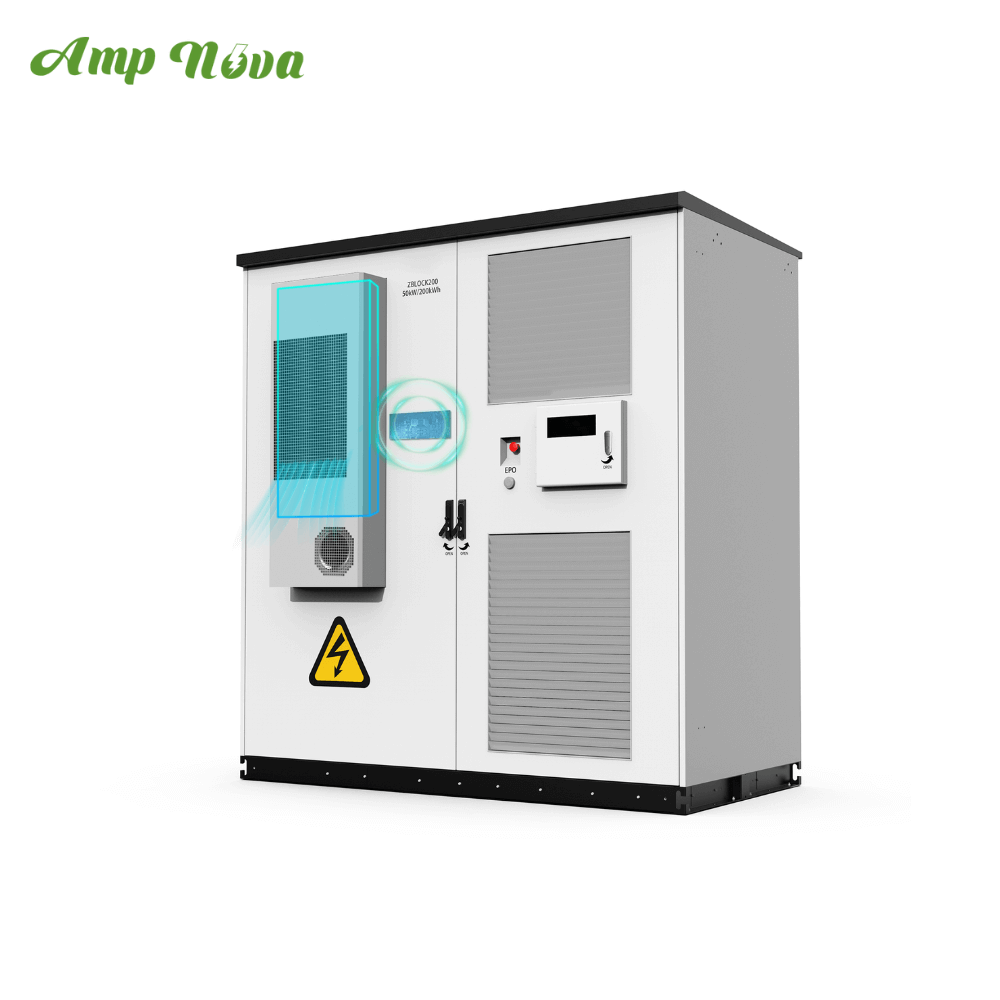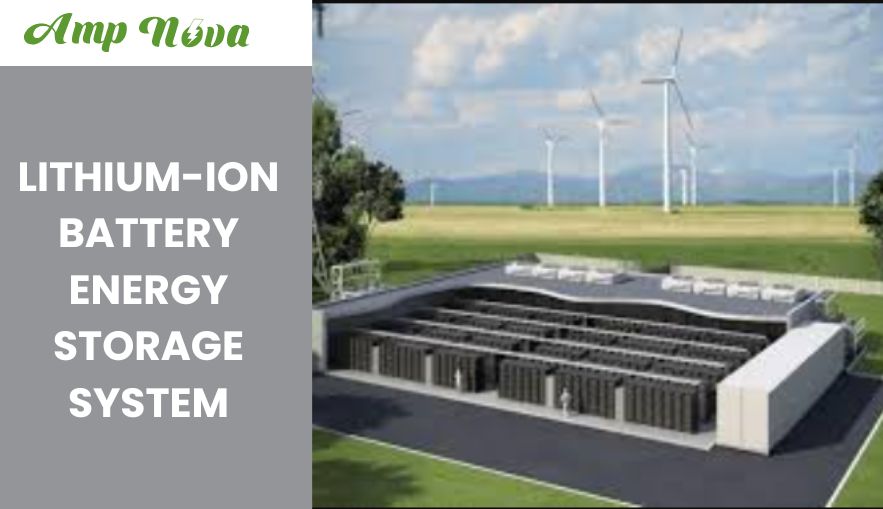Betri ya lithiamu-ion: Katika ulimwengu wa uhifadhi wa nishati, betri za lithiamu-ioni zinaonekana. Ni muhimu kwa maombi mengi leo. Lakini kwa nini ni muhimu sana?
Katika mtengenezaji wa betri za jua, tunaamini katika maelezo wazi na rahisi. Lengo letu ni kukusaidia kuelewa mifumo hii yenye nguvu ya kuhifadhi nishati.
In the United States market, lithium-ion batteries play a vital role. From homes to businesses, their impact is significant. Let's dive into why these batteries matter so much and how they shape our daily lives.
Betri ya Lithium-Ion ni nini?

A lithium-ion battery is a type of rechargeable battery. It's commonly used in many devices today, from smartphones to electric cars. The technology behind these batteries allows for efficient energy storage and long-lasting power.
Vipengele Muhimu
The main components of a lithium-ion battery are the anode, cathode, and electrolyte. Each part plays a crucial role in the battery's function.

Anode
Anode ni upande mbaya wa betri. Inatoa ioni za lithiamu wakati wa kutokwa na kunyonya wakati wa malipo.
Cathode
Cathode ni upande mzuri wa betri. Inachukua ioni za lithiamu wakati wa kutokwa na kuzifungua wakati wa malipo.
Electrolyte
Electroliti ni kati ya kemikali ambayo inaruhusu ioni za lithiamu kusonga kati ya anode na cathode. Harakati hii inaunda nishati ya umeme.
Jinsi Inavyofanya Kazi
When you use a device powered by a lithium-ion battery, here's what happens:
- Utekelezaji: Ioni za lithiamu husogea kutoka kwenye anodi hadi kwenye kathodi kupitia elektroliti.
- Kutolewa kwa Nishati: Harakati hii inazalisha nishati ya umeme, kuwezesha kifaa chako.
- Kuchaji: Unapochaji kifaa chako, ayoni za lithiamu husogea nyuma kutoka kwa kathodi hadi anode.
Mzunguko huu unajirudia zaidi ya chaji na uondoaji mwingi, na kufanya betri hizi kuwa bora kwa matumizi ya kila siku.
Betri za lithiamu-ion ni muhimu kwa maisha ya kisasa. Wanatoa ufumbuzi wa kuaminika wa uhifadhi wa nishati kwa vifaa na programu mbalimbali.
Kwa kuelewa muundo na utendakazi wao msingi, tunaweza kufahamu vyema jinsi wanavyodumisha teknolojia yetu kufanya kazi vizuri kila siku.
Kwa maelezo zaidi kuhusu mifumo ya hifadhi ya nishati au ikiwa una maswali yoyote kuhusu mada hii, jisikie huru kuwasiliana nasi katika [Amp Nova]. Tuko hapa kusaidia!
Manufaa ya Mifumo ya Kuhifadhi Nishati ya Betri ya Lithium-Ion
Lithium-ion battery energy storage systems have revolutionized how we store and use energy. At [Amp Nova], we believe in harnessing the power of this technology to create a more efficient and sustainable future. In this blog, we'll explore the key benefits of lithium-ion battery energy storage systems.
Msongamano mkubwa wa Nishati
Moja ya sifa kuu za betri za lithiamu-ion ni msongamano wao wa juu wa nishati. Hii ina maana kwamba wanaweza kuhifadhi kiasi kikubwa cha nishati ndani ya nafasi ndogo.
Kwa wamiliki wa nyumba na biashara, hii inaleta nguvu zaidi bila kuchukua nafasi nyingi.
Imagine being able to store enough energy to power your home or office for days, all within a compact unit. That's the promise of high energy density with lithium-ion batteries.
Muda mrefu wa Maisha
Urefu wa maisha ni faida nyingine muhimu. Betri za lithiamu-ioni zimeundwa kudumu kwa miaka mingi na matengenezo madogo. Muda huu mrefu wa maisha unamaanisha uingizwaji mdogo na gharama za chini kwa wakati.
It's comforting to know that once you invest in a lithium-ion battery system from [Amp Nova], you're set for years without worrying about frequent replacements or declining performance.
Ufanisi na Utendaji
Linapokuja suala la ufanisi, betri za lithiamu-ion zinaangaza sana. Wanajivunia viwango vya juu vya ufanisi ikilinganishwa na aina nyingine za betri. Hii inamaanisha kupata nishati zaidi inayoweza kutumika kutoka kwa kila mzunguko wa malipo.
Performance-wise, these batteries are reliable even under varying conditions. Whether it's extreme temperatures or fluctuating demand, lithium-ion battery systems consistently deliver optimal performance.
Athari kwa Mazingira
Sustainability is at the heart of Amp Nova's mission, and lithium-ion batteries align perfectly with this goal. These batteries have a lower environmental impact compared to traditional lead-acid batteries.
Lithium-ion battery systems are recyclable and contain fewer toxic materials, making them a greener choice for energy storage solutions. By choosing them, you're contributing to a cleaner and healthier planet.
Hitimisho
Kwa muhtasari, mifumo ya uhifadhi wa nishati ya betri ya lithiamu-ioni hutoa faida nyingi: msongamano mkubwa wa nishati, maisha marefu, ufanisi bora na utendakazi, na kupunguza athari za mazingira.
At Amp Nova, we're committed to providing cutting-edge solutions that help you save money while protecting our environment.
If you're ready to experience the advantages of lithium-ion battery technology firsthand, contact us today! Let's work together towards a brighter and more sustainable future with [Amp Nova].
Maombi nchini Marekani
In today's world, more homeowners are looking for ways to become energy-independent. One popular solution is integrating solar panels with a lithium-ion battery energy storage system from [Amp Nova].
Mchanganyiko huu huruhusu wamiliki wa nyumba kuhifadhi nishati ya jua ya ziada inayozalishwa wakati wa siku za jua na kuitumia usiku au wakati wa mawingu.
Ujumuishaji wa Paneli ya jua
Uunganishaji wa paneli za jua na mfumo wa betri ya lithiamu-ioni hutoa chanzo cha nishati cha kuaminika na endelevu kwa nyumba yako.
By storing the sun's energy, you minimize reliance on the grid, reduce electricity bills, and contribute to a greener environment.
Ugavi wa Nishati chelezo
Kukatika kwa umeme bila kutarajiwa kunaweza kukatisha tamaa. Ukiwa na mfumo wa Amp Nova, unaweza kuwa na amani ya akili ukijua kwamba nyumba yako ina chanzo cha nishati cha kuaminika.
Whether it's a short-term blackout or an extended outage caused by severe weather, our battery systems ensure that essential appliances keep running.
Matumizi ya Kibiashara: Kuimarisha Uendeshaji Biashara
Biashara zinakabiliwa na changamoto za kipekee linapokuja suala la kudhibiti gharama za nishati na kuhakikisha nishati isiyokatizwa. Mifumo ya uhifadhi wa nishati ya betri ya lithiamu-ion ya Amp Nova hutoa manufaa kadhaa yanayolenga mahitaji ya kibiashara.
Uimarishaji wa Gridi
Kudumisha utulivu wa gridi ya taifa ni muhimu kwa kila biashara. Suluhu zetu za hali ya juu za uhifadhi wa nishati husaidia kuleta utulivu wa gridi ya taifa kwa kusawazisha mabadiliko ya ugavi na mahitaji. Hii sio tu kuhakikisha nguvu ya kuaminika lakini pia inasaidia miundombinu ya jumla.
Unyoaji wa Kilele
Biashara nyingi zinakabiliwa na gharama kubwa za umeme wakati wa saa za kilele. Kunyoa kilele husaidia kupunguza gharama hizi kwa kutumia nishati iliyohifadhiwa wakati wa mahitaji makubwa.
Kwa kutumia mifumo ya Amp Nova, biashara zinaweza kuepuka gharama kubwa na kuboresha matumizi yao ya nishati.
Hitimisho: Mustakabali wa Hifadhi ya Nishati na Amp Nova
Mifumo ya kuhifadhi nishati ya betri ya lithiamu-ioni kutoka Amp Nova ina jukumu muhimu katika kubadilisha jinsi tunavyotumia na kudhibiti umeme katika mipangilio ya makazi na biashara kote Marekani.
Kwa kuunganisha paneli za miale ya jua, kutoa nishati mbadala, kuimarisha gridi ya taifa, na kunyoa mizigo ya kilele, suluhu zetu husukuma ufanisi na uendelevu.
Kuwekeza katika mfumo wa Amp Nova kunamaanisha kuwekeza katika siku zijazo ambapo uhuru wa nishati na uokoaji wa gharama unapatikana kwa kila mtu. Gundua bidhaa zetu mbalimbali leo na uchukue hatua ya kwanza kuelekea usimamizi bora wa nishati!

Jinsi ya kuchagua mfumo sahihi?
Choosing the right Lithium-ion battery energy storage system can be tricky. With so many options, knowing what to look for is key. Let's break it down step-by-step.
Kutathmini Mahitaji Yako
Kwanza, elewa kwa nini unahitaji mfumo wa kuhifadhi nishati ya betri ya Lithium-ion. Je, unatazamia kuokoa kwenye bili za umeme, nishati mbadala wakati wa kukatika, au kutumia vyanzo vya nishati mbadala kama vile sola? Kujua kusudi lako kutaongoza uamuzi wako.
Mahitaji ya Uwezo
Next, determine how much power you need. This depends on the size of your home or facility and your typical energy usage. Speak with a professional if you're unsure about this. They can help calculate your needs accurately.
Mazingatio ya Bajeti
Bajeti ni muhimu katika kufanya ununuzi wowote mkubwa. Linganisha mifumo tofauti ya betri ya Lithium-ion ndani ya anuwai ya bei yako. Kumbuka kwamba wakati mwingine kulipa mapema zaidi kunaweza kuokoa pesa kwa muda mrefu kupitia ufanisi bora na maisha marefu.
Baadhi ya Vidokezo:
- Tafuta mauzo au matoleo maalum.
- Fikiria chaguzi za ufadhili.
- Angalia ikiwa kuna punguzo au vivutio vinavyopatikana katika eneo lako.
Kulinganisha Bidhaa
Pamoja na bidhaa kadhaa kwenye soko, kulinganisha ni muhimu:
- Ufanisi: Je, inahifadhi na kutoa nishati kwa kiwango gani?
- Muda wa maisha: Je, inaweza kushughulikia mizunguko mingapi kabla ya utendaji kushuka?
- Kiwango cha Joto: Je, inaweza kufanya kazi vizuri katika hali ya hewa mbalimbali?
Tumia ukaguzi na ukadiriaji unaoaminika kutoka kwa watumiaji wa sasa ili kutoa maoni.
Sifa ya Biashara
Sifa ya chapa ni muhimu wakati wa kuchagua a Betri ya lithiamu-ion mfumo wa kuhifadhi nishati. Bidhaa zinazojulikana kama Amp Nova kuwa na rekodi zilizothibitishwa za ubora na kuegemea. Maoni, maoni ya wateja na maoni ya kitaalamu yanaweza kukuongoza hapa pia.
Udhamini na Msaada
Udhamini mzuri ni ishara ya kujiamini kutoka kwa mtengenezaji. Angalia:
- Kipindi cha Udhamini: Muda mrefu ni kawaida bora.
- Huduma za Usaidizi: Je, kuna usaidizi wa wateja 24/7? Je, mafundi wanapatikana kwa urahisi kwa matengenezo?
Hizi zinaweza kufanya kumiliki na kudumisha mfumo wako bila usumbufu.
Kwa Muhtasari
Kuchagua mfumo unaofaa wa kuhifadhi nishati ya betri ya Lithium-ioni huhusisha kutathmini mahitaji yako, kuelewa mahitaji ya uwezo, kuzingatia vipengele vya bajeti, kulinganisha bidhaa kwa makini, kuangalia sifa ya chapa, na kuhakikisha udhamini thabiti na huduma za usaidizi.
By following these steps, you'll find the perfect fit for your home or business—one that saves money and keeps you powered up efficiently!
Vidokezo vya Ufungaji na Matengenezo
Usakinishaji wa Kitaalam dhidi ya DIY
Ufungaji wa Kitaalamu:
- Utaalamu na Uzoefu: Kuajiri mtaalamu huhakikisha kuwa ufungaji unafanywa na mtu mwenye ujuzi na uzoefu muhimu, kupunguza hatari ya makosa.
- Ulinzi wa Udhamini: Bidhaa nyingi huja na dhamana zinazohitaji ufungaji wa kitaalamu. Usakinishaji wa DIY unaweza kubatilisha dhamana hizi.
- Kuzingatia kanuni: Wataalamu wanafahamu kanuni na kanuni za ujenzi wa ndani, kuhakikisha kwamba ufungaji unafuata.
- Wakati na Urahisi: Wataalamu wanaweza kukamilisha usakinishaji kwa haraka zaidi na kwa ufanisi, na kuokoa muda na juhudi.
Ufungaji wa DIY:
- Uokoaji wa Gharama: Ufungaji wa DIY unaweza kuokoa pesa kwa gharama za kazi.
- Kuridhika kwa kibinafsi: Kukamilisha mradi peke yako kunaweza kuthawabisha na kutimiza.
- Fursa ya Kujifunza: Miradi ya DIY inaweza kutoa ujuzi na ujuzi muhimu kwa kazi za baadaye.
Mazoea ya Matengenezo ya Kawaida
- Kusafisha mara kwa mara: Weka vifaa na vipengele safi ili kuzuia vumbi na uchafu kuathiri utendaji. Tumia vifaa na njia zinazofaa za kusafisha kwa kila sehemu.
- Upakaji mafuta: Hakikisha kuwa sehemu zinazosonga zimetiwa mafuta ya kutosha ili kupunguza uchakavu na uchakavu. Fuata mapendekezo ya mtengenezaji kwa vipindi na aina za lubrication.
- Ukaguzi: Kagua mara kwa mara sehemu zote za mfumo kwa dalili za uchakavu, uharibifu au kutu. Suluhisha maswala haraka ili kuzuia uharibifu zaidi.
- Urekebishaji: Hakikisha kwamba vitambuzi na mifumo ya udhibiti imesahihishwa ipasavyo ili kudumisha utendakazi sahihi.
- Masasisho ya Programu: Sasisha programu au programu dhibiti yoyote ili kufaidika na vipengele vipya zaidi na viraka vya usalama.
Ukaguzi wa Usalama
- Usalama wa Umeme: Kagua miunganisho ya umeme na nyaya mara kwa mara ili kuona dalili za uchakavu, uharibifu au miunganisho iliyolegea. Hakikisha kwamba vipengele vyote vya umeme vimewekwa msingi.
- Vifaa vya Kinga: Tumia vifaa vinavyofaa vya kinga ya kibinafsi (PPE) unapofanya kazi za matengenezo ili kulinda dhidi ya hatari zinazoweza kutokea.
- Taratibu za Dharura: Jifahamishe na taratibu za kuzima dharura na uhakikishe kuwa vipengele vyote vya usalama vinafanya kazi.
- Usalama wa Moto: Weka vizima moto na vifaa vingine vya usalama wa moto kwa urahisi na uhakikishe kuwa vinakaguliwa mara kwa mara.
- Uingizaji hewa: Hakikisha kuwa mifumo ya uingizaji hewa inafanya kazi kwa usahihi ili kuzuia mkusanyiko wa gesi hatari au joto kupita kiasi.
Ufuatiliaji wa Utendaji
- Vipimo vya Utendaji: Establish key performance indicators (KPIs) to monitor the system's performance. Common metrics include efficiency, output, and downtime.
- Mtihani wa Mara kwa Mara: Fanya majaribio ya mara kwa mara ili kuthibitisha kuwa mfumo unafanya kazi ndani ya vigezo vinavyotarajiwa. Hii inaweza kusaidia kutambua masuala yanayoweza kutokea kabla hayajawa matatizo makubwa.
- Uchambuzi wa Data: Kusanya na kuchanganua data ya utendakazi ili kutambua mienendo na maeneo ya kuboresha. Tumia data hii kufanya maamuzi sahihi kuhusu matengenezo na uboreshaji.
- Tahadhari na Arifa: Sanidi arifa na arifa ili kukuarifu kuhusu masuala yoyote ya utendaji au dosari. Hii inaruhusu hatua ya haraka kushughulikia matatizo yoyote.
- Nyaraka: Weka rekodi za kina za shughuli zote za matengenezo, ukaguzi na data ya utendaji. Hati hizi zinaweza kuwa za thamani sana kwa utatuzi na upangaji wa siku zijazo.
Kwa kufuata vidokezo hivi vya usakinishaji na matengenezo, unaweza kuhakikisha kutegemewa kwa muda mrefu, ufanisi na usalama wa vifaa na mifumo yako.
Chapisho Linalohusiana
Betri Mpya za Nishati za Amp Nova: Kuimarisha Ufanisi na Kuegemea
Bess ni nini | Nguvu ya Betri kwa Wakati Ujao Wetu wa Nishati
Hitimisho
Mifumo ya uhifadhi wa nishati ya betri ya lithiamu-ioni ni muhimu kwa kusasisha gridi za nishati na kusaidia ujumuishaji wa nishati mbadala.
Msongamano wao wa juu wa nishati, maisha ya mzunguko mrefu, na kutegemewa huwafanya kuwa bora kwa matumizi mbalimbali, kutoka kwa kuimarisha gridi ya taifa hadi kutoa nishati mbadala.
Kadiri teknolojia inavyoendelea, mifumo hii inazidi kuwa bora na ya gharama nafuu, ikicheza jukumu muhimu katika kuunda siku zijazo za nishati endelevu na sugu.
